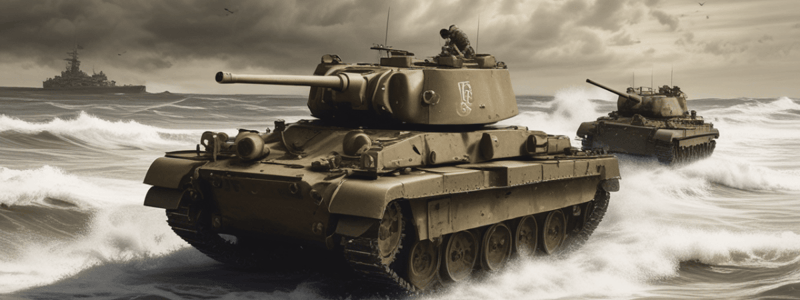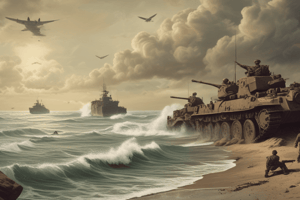Podcast
Questions and Answers
Who was appointed commander of Operation Overlord in January 1944?
Who was appointed commander of Operation Overlord in January 1944?
- Bernard Montgomery
- Winston Churchill
- George Patton
- Dwight Eisenhower (correct)
Why was the invasion delayed from June 5 to June 6, 1944?
Why was the invasion delayed from June 5 to June 6, 1944?
- Due to a problem with the fleet of ships
- Due to bad weather (correct)
- Due to a delay in mobilizing troops
- Due to a German counterattack
What was the approximate number of Allied soldiers landed on the beaches of Normandy by the end of D-Day?
What was the approximate number of Allied soldiers landed on the beaches of Normandy by the end of D-Day?
- 200,000
- 50,000
- 156,000 (correct)
- 100,000
Which of the following beaches saw over 2,000 American casualties during the D-Day invasion?
Which of the following beaches saw over 2,000 American casualties during the D-Day invasion?
What was the significance of the Normandy invasion?
What was the significance of the Normandy invasion?
What was the role of the 11,000 aircraft mobilized for the invasion?
What was the role of the 11,000 aircraft mobilized for the invasion?
Match the following individuals with their roles in the D-Day invasion:
Match the following individuals with their roles in the D-Day invasion:
Match the following dates with their corresponding events:
Match the following dates with their corresponding events:
Match the following locations with their significance in the D-Day invasion:
Match the following locations with their significance in the D-Day invasion:
Match the following terms with their descriptions:
Match the following terms with their descriptions:
Flashcards are hidden until you start studying
Study Notes
D-Day Invasion
- The D-Day invasion took place on June 6, 1944, as Allied troops from the US, Canada, UK, and other countries invaded Normandy's beaches in northern France.
- At the time, France was occupied by Nazi Germany's armies.
Operation Overlord
- Operation Overlord was the codename for the D-Day invasion, led by General Dwight Eisenhower.
- The operation aimed to land 156,000 Allied soldiers on Normandy's beaches by the end of the day.
Deception Operation
- The Allies conducted a massive deception operation to make the Germans believe the main invasion target was Pas-de-Calais, not Normandy.
- Tactics used included fake equipment, a phantom army, double agents, and fraudulent radio transmissions.
Invasion Planning
- Eisenhower selected June 5, 1944, as the initial date for the invasion, but bad weather caused a 24-hour delay.
- On the morning of June 5, Eisenhower gave the go-ahead for Operation Overlord after predicting improved weather conditions.
Invasion Forces
- Over 5,000 ships and landing craft carrying troops and supplies left England for France.
- More than 11,000 aircraft were mobilized to provide air cover and support for the invasion.
Amphibious Invasion
- The amphibious invasion began at 6:30 a.m. on June 6, 1944.
- British and Canadian forces captured beaches codenamed Gold, Juno, and Sword with light opposition.
- American forces faced heavy resistance at Omaha Beach, with over 2,000 casualties.
Success and Aftermath
- By the end of the day, approximately 156,000 Allied troops had successfully stormed Normandy's beaches.
- Estimates suggest over 4,000 Allied troops lost their lives, with thousands more wounded or missing.
- Within a week, the beaches were fully secured, and over 326,000 troops, 50,000 vehicles, and 100,000 tons of equipment had landed at Normandy.
- The Normandy invasion marked a turning point against the Nazis, leading to their formal surrender on May 8, 1945.
D-Day Invasion
- The D-Day invasion took place on June 6, 1944, as Allied troops from the US, Canada, UK, and other countries invaded Normandy's beaches in northern France.
- At the time, France was occupied by Nazi Germany's armies.
Operation Overlord
- Operation Overlord was the codename for the D-Day invasion, led by General Dwight Eisenhower.
- The operation aimed to land 156,000 Allied soldiers on Normandy's beaches by the end of the day.
Deception Operation
- The Allies conducted a massive deception operation to make the Germans believe the main invasion target was Pas-de-Calais, not Normandy.
- Tactics used included fake equipment, a phantom army, double agents, and fraudulent radio transmissions.
Invasion Planning
- Eisenhower selected June 5, 1944, as the initial date for the invasion, but bad weather caused a 24-hour delay.
- On the morning of June 5, Eisenhower gave the go-ahead for Operation Overlord after predicting improved weather conditions.
Invasion Forces
- Over 5,000 ships and landing craft carrying troops and supplies left England for France.
- More than 11,000 aircraft were mobilized to provide air cover and support for the invasion.
Amphibious Invasion
- The amphibious invasion began at 6:30 a.m. on June 6, 1944.
- British and Canadian forces captured beaches codenamed Gold, Juno, and Sword with light opposition.
- American forces faced heavy resistance at Omaha Beach, with over 2,000 casualties.
Success and Aftermath
- By the end of the day, approximately 156,000 Allied troops had successfully stormed Normandy's beaches.
- Estimates suggest over 4,000 Allied troops lost their lives, with thousands more wounded or missing.
- Within a week, the beaches were fully secured, and over 326,000 troops, 50,000 vehicles, and 100,000 tons of equipment had landed at Normandy.
- The Normandy invasion marked a turning point against the Nazis, leading to their formal surrender on May 8, 1945.
D-Day Invasion
- The D-Day invasion took place on June 6, 1944, as Allied troops from the US, Canada, UK, and other countries invaded Normandy's beaches in northern France.
- At the time, France was occupied by Nazi Germany's armies.
Operation Overlord
- Operation Overlord was the codename for the D-Day invasion, led by General Dwight Eisenhower.
- The operation aimed to land 156,000 Allied soldiers on Normandy's beaches by the end of the day.
Deception Operation
- The Allies conducted a massive deception operation to make the Germans believe the main invasion target was Pas-de-Calais, not Normandy.
- Tactics used included fake equipment, a phantom army, double agents, and fraudulent radio transmissions.
Invasion Planning
- Eisenhower selected June 5, 1944, as the initial date for the invasion, but bad weather caused a 24-hour delay.
- On the morning of June 5, Eisenhower gave the go-ahead for Operation Overlord after predicting improved weather conditions.
Invasion Forces
- Over 5,000 ships and landing craft carrying troops and supplies left England for France.
- More than 11,000 aircraft were mobilized to provide air cover and support for the invasion.
Amphibious Invasion
- The amphibious invasion began at 6:30 a.m. on June 6, 1944.
- British and Canadian forces captured beaches codenamed Gold, Juno, and Sword with light opposition.
- American forces faced heavy resistance at Omaha Beach, with over 2,000 casualties.
Success and Aftermath
- By the end of the day, approximately 156,000 Allied troops had successfully stormed Normandy's beaches.
- Estimates suggest over 4,000 Allied troops lost their lives, with thousands more wounded or missing.
- Within a week, the beaches were fully secured, and over 326,000 troops, 50,000 vehicles, and 100,000 tons of equipment had landed at Normandy.
- The Normandy invasion marked a turning point against the Nazis, leading to their formal surrender on May 8, 1945.
D-Day Invasion
- The D-Day invasion took place on June 6, 1944, as Allied troops from the US, Canada, UK, and other countries invaded Normandy's beaches in northern France.
- At the time, France was occupied by Nazi Germany's armies.
Operation Overlord
- Operation Overlord was the codename for the D-Day invasion, led by General Dwight Eisenhower.
- The operation aimed to land 156,000 Allied soldiers on Normandy's beaches by the end of the day.
Deception Operation
- The Allies conducted a massive deception operation to make the Germans believe the main invasion target was Pas-de-Calais, not Normandy.
- Tactics used included fake equipment, a phantom army, double agents, and fraudulent radio transmissions.
Invasion Planning
- Eisenhower selected June 5, 1944, as the initial date for the invasion, but bad weather caused a 24-hour delay.
- On the morning of June 5, Eisenhower gave the go-ahead for Operation Overlord after predicting improved weather conditions.
Invasion Forces
- Over 5,000 ships and landing craft carrying troops and supplies left England for France.
- More than 11,000 aircraft were mobilized to provide air cover and support for the invasion.
Amphibious Invasion
- The amphibious invasion began at 6:30 a.m. on June 6, 1944.
- British and Canadian forces captured beaches codenamed Gold, Juno, and Sword with light opposition.
- American forces faced heavy resistance at Omaha Beach, with over 2,000 casualties.
Success and Aftermath
- By the end of the day, approximately 156,000 Allied troops had successfully stormed Normandy's beaches.
- Estimates suggest over 4,000 Allied troops lost their lives, with thousands more wounded or missing.
- Within a week, the beaches were fully secured, and over 326,000 troops, 50,000 vehicles, and 100,000 tons of equipment had landed at Normandy.
- The Normandy invasion marked a turning point against the Nazis, leading to their formal surrender on May 8, 1945.
Studying That Suits You
Use AI to generate personalized quizzes and flashcards to suit your learning preferences.




